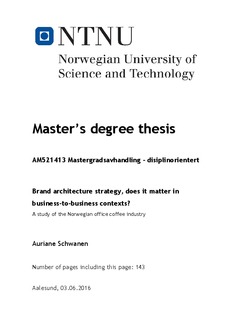| dc.contributor.advisor | Pasquine, Mark | |
| dc.contributor.author | Schwanen, Auriane | |
| dc.date.accessioned | 2016-10-26T12:50:51Z | |
| dc.date.available | 2016-10-26T12:50:51Z | |
| dc.date.issued | 2016 | |
| dc.identifier.uri | http://hdl.handle.net/11250/2417822 | |
| dc.description.abstract | The amount of researches conducted on branding in the business-to-business field across all industries is significantly less numerous than the amount of researchers aiming at understanding the concept of branding in the business-to-consumer field. In addition, very few studies, if not none, have intended to get a better understanding and to quantify the Norwegian coffee market. For these two reasons, this study focuses on the Norwegian office coffee industry, and is therefore aiming at getting a better understanding of the business-to-business branding field in the Norwegian coffee industry. | nb_NO |
| dc.description.abstract | Firms exhibit or implement two main types of brand architecture strategies: branded-house and house-of-brands. These two strategies differ in their essential structure and their potential costs and benefits to the corporation. Prior research has failed to understand how these branding strategies are related and interacts with the three brand equity measures; brand assets, brand strength and brand value. The main goal of this study is therefore to investigate the relationship between brand architecture strategy and brand equity as an indicator of firm performance. | nb_NO |
| dc.description.abstract | To investigate this link, a focus market has been selected: the Norwegian office coffee market. In addition, a two-taxonomy brand architecture strategy has been carefully selected: branded-house, and house-of-brands. And finally, the following firm performance measurement system has been chosen: brand equity, which is composed and therefore measured through brand assets, brand strength and brand value. Using these three measures of brand equity as firm performance indicators in a study focusing on brand architecture strategy is an innovative way to look at the relationship between brand structure and brand equity as this measurement system has so far never been implemented in this context. | nb_NO |
| dc.description.abstract | In this multi-method study, the link between brand architecture strategy and brand performance is investigated by using two distinct surveys. The two distinct questionnaires that have been implemented and conducted have been organised as follows. The first questionnaire conducted was directed to the companies active in the Norwegian office coffee industry, while the second questionnaire was aiming at getting a better understanding of the customer preferences in this particular industry. In total, 4 firms and 138 individuals have accepted to participate in this study. In addition to these two main surveys, a third "fast-track" survey has been conducted at the end of the project in order to clarify some results observed in the two previous surveys. | nb_NO |
| dc.description.abstract | The results of this research showed that in general, the house-of-brands architecture strategy seems to be associated with higher brand assets, brand strength and brand value than the branded-house architecture strategy. Therefore, on the Norwegian office coffee industry, higher brand equity levels are found in firms implementing a house-of-brands architecture strategy compared to firms implementing a branded-house architecture strategy. In addition, the average house-of-brands architecture usually is significantly older, but also requires almost ten times more employees than the average branded-house architecture. In addition, the importance of leveraging the corporate brand is also debated. Furthermore, I would like to highlight the fact that this study represents a good starting point for future research on brand architecture strategy. Finally, limitations as well as managerial implications are also discussed as part of this paper. | nb_NO |
| dc.description.abstract | Key words - Brand architecture strategy, brand structure, branding, brand equity, business-to-business, corporate brand. | nb_NO |
| dc.language.iso | eng | nb_NO |
| dc.rights | Navngivelse-Ikkekommersiell-IngenBearbeidelse 3.0 Norge | * |
| dc.rights.uri | http://creativecommons.org/licenses/by-nc-nd/3.0/no/ | * |
| dc.subject | Coffee | nb_NO |
| dc.subject | Brand awareness | nb_NO |
| dc.subject | Markedsplassering | nb_NO |
| dc.title | Brand architecture strategy, does it matter in business-to-business contexts? A study of the Norwegian office coffee industry. | nb_NO |
| dc.type | Master thesis | nb_NO |
| dc.subject.nsi | VDP::Social science: 200::Economics: 210 | nb_NO |
| dc.source.pagenumber | 143 | nb_NO |

